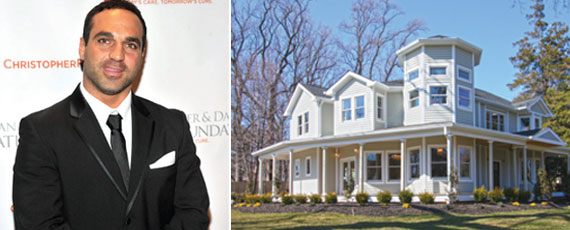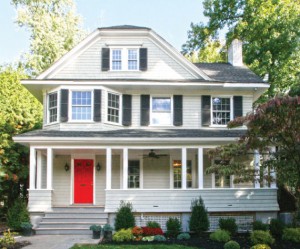Trending
Old homes come downas the market heats up
Teardowns are back in vogue as</br> small developers place big bets </br>on residential real estate

With new home building picking up steam in the Northern New Jersey suburbs, investors like Joe Gorga — a cast member of “The Real Housewives of New Jersey” and brother of one of the reality show’s stars, Teresa Giudice — are getting in on the action.
“He just finished a house in Montclair that he’s probably going to sell for around $1 million,” said David Hansel, president of Alpha Funding Solutions in Lakehurst, New Jersey, which provides financing to builders so they can come in as cash buyers and close quickly.
The project was a nearly 3,500-square-foot, four-bedroom, four-and-a-half-bath house, said Hansel, whose firm provided 90 percent of the cost of the project to Gorga. “He does a handful of deals each year,” Hansel said.
Controversial reality TV stars aren’t the only ones. With housing prices in New York and Hoboken pushing many families out to the suburbs, many communities are seeing roomy new homes spring up on lots where older homes have been torn down or undergone major renovations.
As the housing market has stabilized, builders have become more confident they will get the returns they expect, and are gravitating to larger projects, said Hansel. With about 200 loans in its portfolio currently, his firm’s average loan size is $360,000, but deals can range from $100,000 to $10 million, he said.
“Two years ago, people were doing smaller renovation projects,” said Hansel. “We’re seeing a lot of the experienced guys now either doing a second floor, bumping out a Cape, maybe tearing down a house and building new one. A couple of years ago people weren’t taking those risks of doing a larger project.”
Regionally, demand for new construction is picking up. The U.S. Census Bureau found that there were 44,000 single-unit, privately owned housing units started in the Northeast in March 2015. That is down from 50,000 in March of last year, but a sharp increase from February 2015, when there were 22,000 single-unit housing starts during the dreary cold month.
“You see it in Montclair, Essex Fells, Short Hills, Summit and Westfield,” said Ray Rodriguez, vice president, regional mortgage sales manager at TD Bank for the Metro New York region, including Northern New Jersey.
“They have great school districts,” said Rodriguez. “Young families want to move to a town with a great school system and have the house of their dreams.”
Some of the families are coming from New York City, where the average listing price for a two-bedroom apartment on Trulia the first week in April was $2.8 million. And Rodriguez said the migration is not just from Manhattan.“Young families from Brooklyn are moving all the way to New Jersey,” he said.
Others already live in suburban communities and want to trade up.

This Montclair home with a two-story addition has a listing price of $875,000.
“Maybe they’ve lived in a $500,000 home for seven or eight years and they are doing well in their career,” said Paul Lamastra, an associate broker with ERA Suburb Realty Agency in Scotch Plains. “They upgrade.”
Prices aren’t low in the New Jersey suburbs, but they are more affordable than New York City. The National Association of Realtors found that the median sales price of existing single-family homes in the New York metro area — including Northern New Jersey, Long Island and parts of Pennsylvania —was $395,900 in 2014, up from $379,300 in 2012 and $381,300 in 2013.
By all accounts, most of the construction is being done by local small and midsized builders. “Your larger developers are mostly doing condos and large rentals,”
said Rodriguez.
Some investors are aggressively searching for older homes to flip. Hansel said people will go out and drive around and find homes in towns they are focused on. “We’re seeing a lot of activity in North Jersey, through all the towns. They are picking up a lot of these distressed homes, putting on additions, rehabbing them and putting them back into the market.”
Among recent deals Hansel’s firm has financed is a $350,000 gut renovation of a 2,600-square-foot home in Summit, where he anticipates the home, once complete, will sell for $1.2 million. The project is a joint venture between Alpha Funding Solutions and the rehab firm.
Alpha Funding Solutions has also financed two 3,000-square-foot, four-bedroom, four-and-a-half bath Colonials that Hansel anticipates will sell for about $950,000 each in Livingston.
Lamastra said he has seen substantial activity in both Scotch Plains and in Westfield. He said only a few are renovations of older homes.
“The majority are total knockdowns,” Lamastra said. “I don’t see that changing for a long time.”
One reason is economics. “A lot of these older homes are 70 to 100 years old,” he said. “You can only repair them for so long.”
Among the new homes going up, Colonials, with their traditional peaks, are popular locally. “They’re more dimensional than the construction of the sixties and seventies,” he said.
In his area of Union County, Lamastra said he is seeing larger footprints of 3,500 square feet or more, with some as large as 5,000 square feet. Most of the new homes have four or five bedrooms. Price points range from $850,000 to $1.7 or $1.8 million, with the highest-end homes mostly in Westfield. In the projects above $800,000, one popular trend is to include an au pair suite, with a fifth bedroom and its own bathroom, he said.
“It seems like, in order for builders to make money, they have to go larger,” he said.
One challenge in some neighborhoods is small lot sizes that make it hard to build larger homes, noted Lamastra. Some builders are installing both a finished basement and attic in those cases, he said, adding that they “can’t get enough square footage, width-wise.”
But those challenges don’t seem to be scaring off investors and builders.
“Now, because there is so much activity, there are lenders coming out of the woodwork,”
said Hansel.




